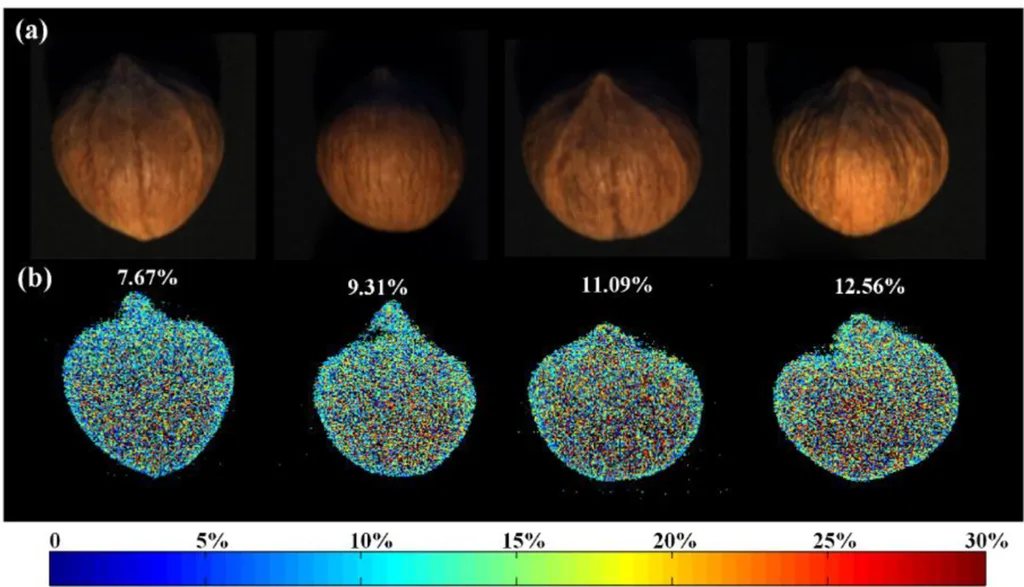In the heart of China, a team of researchers has pioneered a groundbreaking method for rapid, non-destructive moisture analysis in hawthorn fruits, a development that could revolutionize quality control and sorting in the agricultural and food processing industries. Led by Dr. Bai Ruibin from the State Key Laboratory for Quality Ensurance and Sustainable Use of Dao-di Herbs at the China Academy of Chinese Medical Sciences, the study integrates hyperspectral imaging (HSI) with machine learning algorithms to provide real-time, accurate moisture content determination.
Hawthorn, a fruit widely used in traditional Chinese medicine and as a nutritious food source, requires precise moisture content monitoring to ensure quality and prevent spoilage. Traditional methods of moisture analysis are often time-consuming and destructive, making them impractical for large-scale industrial use. The research team’s innovative approach addresses these challenges by employing HSI technology, which captures detailed spectral information from the fruit’s surface.
“The key to our success lies in the combination of hyperspectral imaging and advanced machine learning techniques,” explains Dr. Bai. “By analyzing the spectral data, we can accurately predict the moisture content of hawthorn fruits without causing any damage.”
The study involved collecting 458 fresh hawthorn samples from various regions and cultivars to ensure diversity and robustness. Hyperspectral images were acquired in two spectral ranges: visible-near-infrared (VNIR, 400~1,000 nm) and short-wave infrared (SWIR, 940~2,500 nm). The researchers evaluated the effects of different fruit orientations and spectral ranges on model performance, ultimately finding that the optimal results were achieved when the stem-side of the fruit was facing downward, using the SWIR range and first derivative preprocessing.
Four regression algorithms were employed to build predictive models: partial least squares regression (PLSR), support vector regression (SVR), random forest (RF), and multilayer perceptron (MLP). The SVR model exhibited the highest predictive accuracy, with a coefficient of determination (R²ₚ) of 0.8605, mean absolute error (MAEₚ) of 0.7111, root mean square error (RMSEₚ) of 0.9142, and residual prediction deviation (RPD) of 2.6776.
To further enhance the practicality of the method, the researchers applied four feature selection techniques to reduce data dimensionality and minimize redundancy. The discrete wavelet transform combined with stepwise regression (DWT-SR) method proved particularly effective, selecting 17 key wavelengths that maintained strong predictive capability while significantly reducing input size.
“This research not only provides a rapid and non-destructive method for moisture analysis but also offers valuable insights into the spectral characteristics of hawthorn fruits,” says Dr. Wang Hongpeng, a co-author of the study from the School of Biological and Chemical Engineering at Zhejiang University of Science and Technology. “The findings have significant implications for quality control, moisture monitoring, and automated fruit sorting in the agricultural and food processing industries.”
The study, published in the journal ‘智慧农业’ (translated as ‘Smart Agriculture’), highlights the potential of hyperspectral imaging and machine learning techniques in agricultural applications. As the demand for high-quality, nutritious food continues to grow, innovative technologies like these will play a crucial role in ensuring food safety and sustainability.
The implications of this research extend beyond the hawthorn industry, offering a blueprint for similar applications in other agricultural sectors. By integrating advanced imaging technologies with machine learning algorithms, researchers can develop rapid, non-destructive methods for quality control and monitoring, ultimately enhancing efficiency and reducing waste in the food processing industry.
As the world grapples with the challenges of climate change and food security, innovations in agricultural technology will be essential in meeting the demands of a growing population. The work of Dr. Bai and his team represents a significant step forward in this endeavor, demonstrating the power of interdisciplinary research in addressing real-world problems.
In the words of Dr. Bai, “Our goal is to translate these research findings into practical applications that can benefit farmers, processors, and consumers alike. By leveraging the latest advancements in technology, we can create a more sustainable and efficient agricultural system for the future.”

